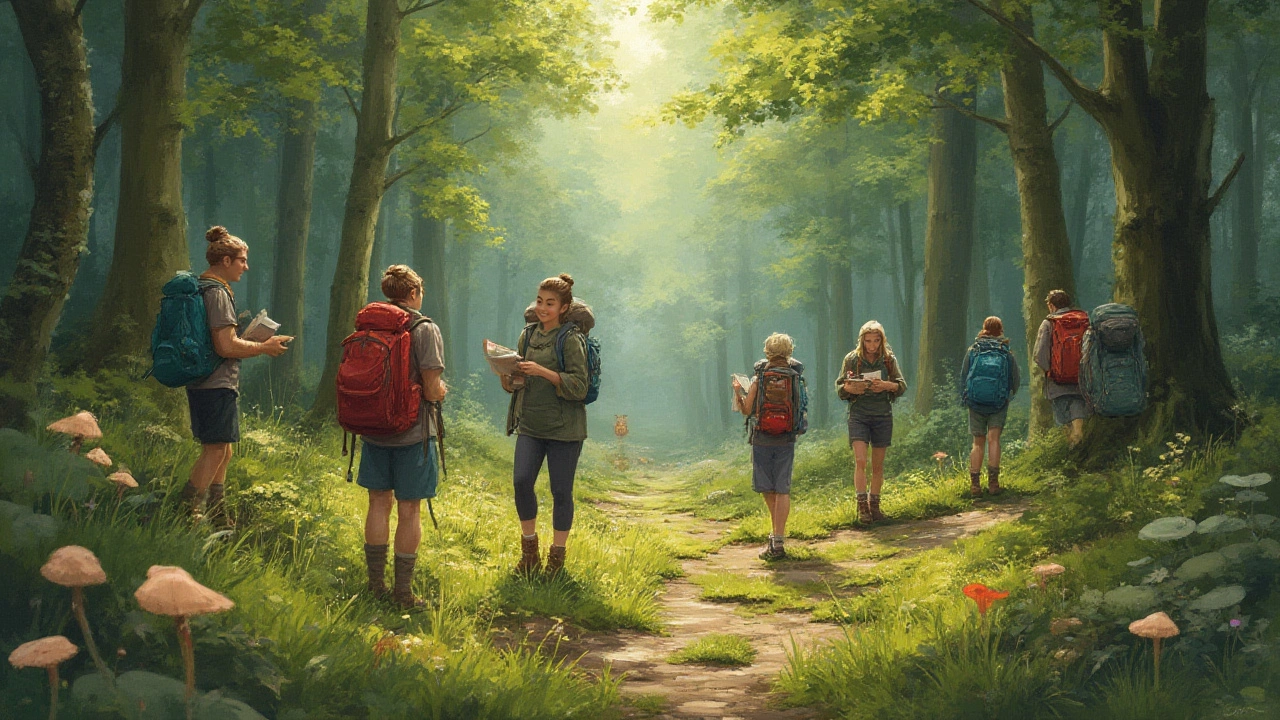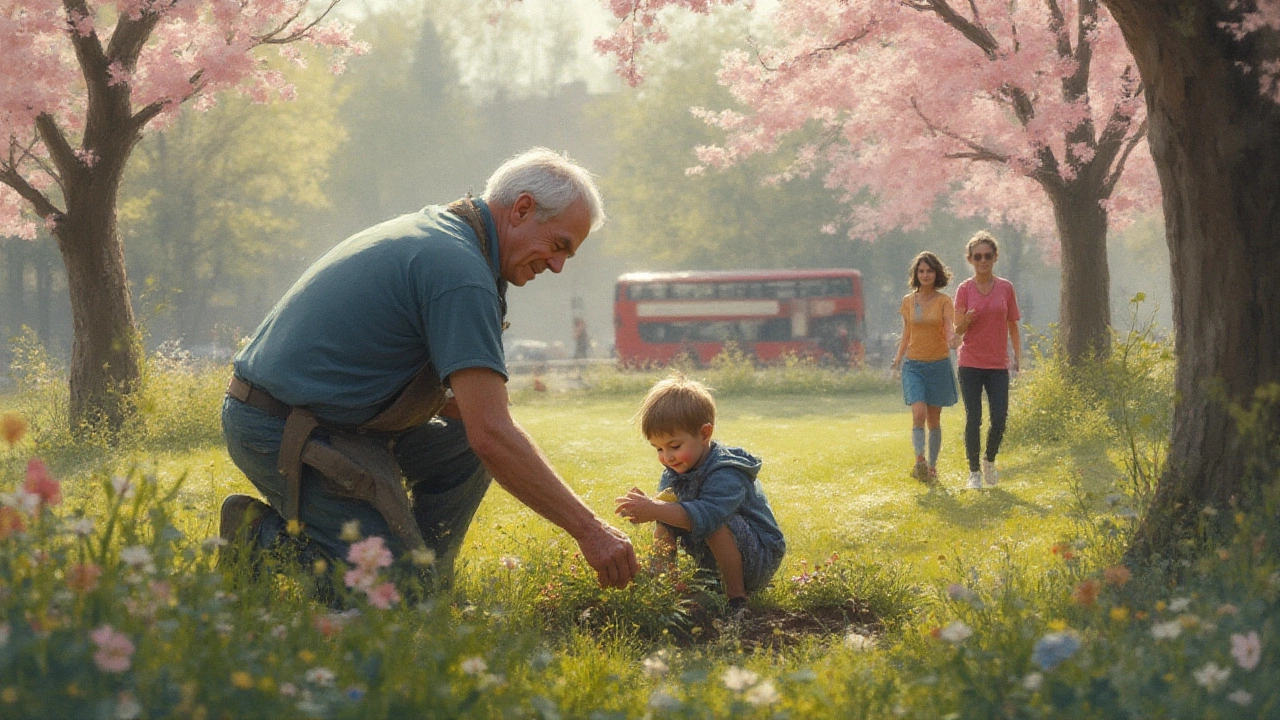You'd be amazed how stepping outside can flip your mood with the touch of a breeze or the sound of rustling leaves. People talk about 'nature-based activities' a lot these days, but what does that even mean? It’s not just wild camping or mountain hiking for ultra-athletes. Even a low-key picnic in the neighborhood park or gardening in your backyard counts. Basically, any activity that gets you physically or mentally involved with the natural world—whether that’s the city waterfront, a local trail, or a hidden garden patch—fits the bill. Time and again, studies show people are happier and healthier when they regularly unplug outdoors. Maybe it’s our brains still wired for ancient forests, maybe it’s the Vitamin D, or just a break from screens—regardless, the perks are real and easy to grab.
Defining Nature-Based Activities
Nature-based activities aren’t just about trudging up mountains or braving the wild. At its core, it’s any experience that purposefully connects you to the outdoors—even if it’s just for a little while. This could mean forest bathing in the local woods (yep, it’s a real thing, and it started in Japan as “Shinrin-yoku” where people spend mindful time among trees), creating detailed sketches of birds in your backyard, or working up a sweat on a paddleboard. The point is: it’s not about remoteness or extreme adventure; it’s about engagement with the natural world, wherever you can find it.
Data from the European Environment Agency in 2024 shows urban dwellers report better mental health when they spend at least two hours weekly in greenspaces. And let’s not forget: a 2023 Oxford University study linked nature exposure to reduced anxiety and improved sleep quality among teenagers—who, let’s be honest, are not easy to impress. Gardening, hiking, trail-running, swimming in lakes, urban foraging, birdwatching—the list goes on and keeps growing. Even caring for a potted plant on a balcony can qualify.
Here’s a kicker: the COVID-19 pandemic completely changed how folks defined nature-based activities. With travel off the cards, people embraced microadventures: 20-minute walks in local parks, cloud-watching from balconies, or even building DIY bug hotels for backyard critters. So you don’t need to be an outdoor superstar; you just need curiosity and a little spare time.
| Activity | Urban or Rural? | Best For |
|---|---|---|
| Birdwatching | Both | Everyone, especially if you love noticing details |
| Trail-running | Usually rural | Those who like movement and fresh air |
| Community Gardening | Urban | People who want hands-on nature with a social twist |
| Paddleboarding | Both | Adventurers looking for something different |
| Foraging | Rural, Suburban | Foodies, explorers, and curious types |
No two nature-based experiences are identical, and that’s the fun of it. You might sink into meditation on a forest log one afternoon and join a guided mushroom walk the next week. Trying something new often means learning about seasons, animal rhythms, and even the history of your own neighborhood. And you’ll always return home with stories—sometimes muddy shoes, too.
Why Nature-Based Activities Matter
Ever heard about the “nature deficit disorder?” It’s not a clinical label, but the phrase is catching on. In the last few decades, people have swapped park visits for screen time, leaving us a bit nature-starved. Richard Louv came up with the term back in his 2005 book, and it still rings true today. The consequences are sneaky—less focus, more stress, reduced creativity, and surprisingly, even weaker immune defenses. Turns out, our bodies expect to get a little dirty and windblown now and then.
Doctors in New Zealand regularly prescribe forest walks for patients suffering from burnout or mild depression, and some Canadian physicians hand out “nature prescriptions” to boost mood and fitness. If a stroll through trees can rival a pharmacy trip, why not take that advice seriously? According to a 2024 American Psychological Association paper, adults who spent time in natural settings reported a 25% drop in stress hormones. Kids fidget less, adults feel less anxious, and couples claim deeper conversations when sharing outdoor time—no filters needed.
Nature-based activities also nudge you toward physical wellness without it feeling like a chore. Instead of counting steps or dreading the gym, people notice they’re happier to walk for miles when the landscape is interesting—giant trees, fluttering butterflies, or hidden ponds make every walk a tiny adventure. A Finnish study from 2022 found that people who regularly engaged in outdoor recreation had 33% fewer doctor visits relating to musculoskeletal issues. So, yes, your future self will thank you for the extra legwork.
You also get the bonus of unplugging from buzz and notifications. Switching off our wired lives and switching on “natural awareness” is like hitting the reset button on your brain. Suddenly you notice: birds you never saw, small wildflowers hiding in plain sight, the shift of seasons. It feels a lot like waking up from autopilot. And the beauty of nature-based activities? They’re free, accessible, and ready to surprise you anytime the mood strikes.

Types of Nature-Based Activities
You don’t need to be the classic outdoorsy type to find a nature-based activity that fits. Some people go all-in with things like long-distance hiking, mountain biking, or kayaking. For those who’d rather keep things gentle, there are wildflower walks, sketching, or reading under a shady tree. The options range from fast-paced thrills to contemplative quiet moments.
Let’s break this down:
- Nature hikes: Not all trails demand gear and grit. Look for local walking loops or even riverside paths. Bring a friend, or fly solo with a podcast.
- Wildlife watching: This might mean binoculars and a guidebook, or just your own two eyes and a smartphone for capturing curious bugs or squirrels. Record what you see; you’ll start spotting seasonal patterns soon.
- Water-based fun: Swimming in lakes or rivers gives a literal full-body reset. Paddleboarding is gentle but surprisingly good exercise, and some city parks even have kayak rentals for a new perspective.
- Gardening and foraging: Some of life’s small pleasures are digging in dirt or learning which wild plants are edible. Urban gardens offer social fun plus fresh produce, and foragers love free seasonal treats like wild garlic or blackberries.
- Mindful outdoor practices: Yoga or tai chi practiced on soft grass mellow out the nervous system. Even guided forest meditation apps can help you kickstart mindfulness outside if you’re new to the idea.
Don’t underestimate activities like landscape photography, outdoor painting, or even volunteering for river clean-ups. These not only help you tune into your surroundings but might connect you with other people looking for the same thing: a reset, some inspiration, and kinship with nature. Your local park probably has more going on than you think—community groups sometimes host stargazing nights, wildflower walks, or foraging classes. Check those bulletin boards or neighborhood Facebook groups; you’ll be surprised how many opportunities pop up just down the road.
Still stuck for ideas? Here’s a handy quick-start tip: combine an existing hobby with the outdoors. If you love music, learn to play an instrument in a shaded nook. Into writing? Take a notebook outside, and let nature be your prompt. Dog owners already have a leg up—walking your pup on a new trail totally counts.
Tips for Making the Most of Nature-Based Activities
Jumping into the world of nature-based fun doesn’t require expensive gear or elaborate planning. Start small and don’t overthink it. Your first “activity” could be as simple as lunch on a park bench—seriously! Here are some solid tricks to enrich your outdoor experience and make it stick as a regular habit.
- Time your outings: Early mornings and golden hour in the afternoon are magical—less noise, cooler temperatures, and richer light for photos or simply seeing details you’d miss midday.
- Unplug selectively: Snap a quick photo and then stash your phone. Let yourself soak up the moment. If you like music or podcasts, pre-download a nature-themed episode for the walk (try BBC’s nature soundscapes series if you want to geek out).
- Dress the part—comfortably: Don’t stress about fancy boots. Just wear shoes that can get muddy. Layers help you adapt as the temperature shifts.
- Track your mood: After each activity, jot a phrase or two describing how you felt. Over time, it’s a mini diary of nature’s real effects.
- Buddy up: Nature-based activities often stick better when shared. Social connection plus nature gives double the mental benefits, as Harvard research on “green socializing” showed last year.
- Pick up a field guide: Even digital ones work. Start learning the names of plants, birds, and insects you encounter. With identification apps, it’s easier than ever and makes every outing a treasure hunt.
- Stay safe: Sunblock, water, a snack, and a basic first aid kit are always smart. If you’re going somewhere new or remote, tell someone.
- Look for free resources: Libraries, local conservation groups, and city councils often publish walk maps or host outdoor workshops for all ages.
Fact: Even a quick 20-minute walk in a leafy park can drop your blood pressure by 10 points, as measured by MIT’s Urban Nature Study conducted last fall. And if you love tech, wearables now track heart rate and even “nature exposure minutes”—so you get instant feedback and motivation.

The Future of Nature-Based Activities
Nature-based activities aren’t some fleeting fad. Corporate wellness programs are now baking lunchtime walks into the weekly grind, and schools set up outdoor classrooms even in busy cities. The World Health Organization named urban greenspaces “essential infrastructure” in 2024, after compiling mountains of data showing people just do better—mentally, socially, physically—when they have easy access to outdoor fun. (The future isn’t VR goggles on the couch; it’s green boots on real ground.)
Technology might actually encourage people to get out more, not less. Apps like Seek or eBird gamify wildlife sightings, and interactive park maps guide even first-timers to hidden gems. Some towns are experimenting with “wild corridors”—trails that link neighborhoods with parks, making it routine to slip away from traffic and step into a green space. City planners are realigning priorities so nature isn’t just an afterthought, but an ingredient in daily life. Urban beekeeping, rooftop gardens, pop-up tree nurseries—these spaces are rewilding cities, one event at a time.
But there’s more to come. Researchers in Sweden are piloting 'eco-therapy zones'—sections of parks designed for meditation, quiet reflection, or barefoot walking on soft moss. Across the US, land trusts set up “nature prescription kiosks,” where families punch in zip codes and get seasonal nearby hiking suggestions. It’s wild how many creative spins there are now on classic nature time.
So next time your brain feels fuzzy or you’re itching for a reset, step outdoors. Wherever you are, whatever you love, nature-based activities are ready and waiting. The world is messy, beautiful, and way more interesting when you look up from your screen and sink into the bigger picture—even if it’s just for a moment.

